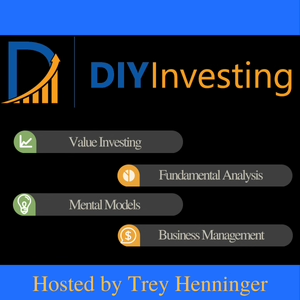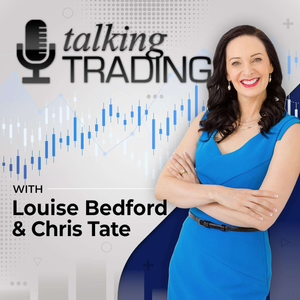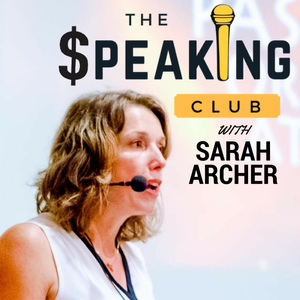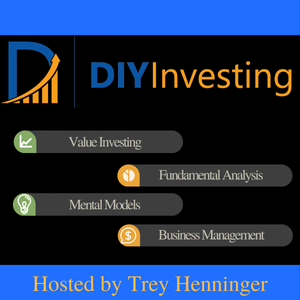
85 - Precisely Wrong, Roughly Right (DCFs)
07/27/20 • 36 min
1 Listener
- Discount Rates
- Gordon Growth Model
- Discounted Cash Flow Calculation
If you enjoyed this podcast and found it helpful, please consider leaving me a rating and review. Your feedback helps me to improve the podcast and grow the show's audience.
Follow me on Twitter and YouTubeTwitter Handle: @TreyHenninger
YouTube Channel: DIY Investing
Support the Podcast on PatreonThis is a podcast supported by listeners like you. If you’d like to support this podcast and help me to continue creating great investing content, please consider becoming a Patron at DIYInvesting.org/Patron.
You can find out more information by listening to episode 11 of this podcast.
Show OutlineThe full show notes for this episode are available at https://www.diyinvesting.org/Episode85
Why DCFs should not be used- What is a DCF?
- An estimate of all future cash flow (dividends or earnings) and discounted back to the present.
- When you add up these values you get the intrinsic value of a company.
- Gordon Growth Model (perpetual constant growth of a dividend - DCF)
- P = Div (next year’s) / (r-g)
- R = discount rate (10%)
- G = constant growth rate in perpetuity.
- Example:
- Dividend = $1.64 (Coca-Cola)
- Specific estimates: $27.85 (based on specific year estimates)
- Growth rate: 3% = $23.42 (equivalent to a 7% dividend yield)
- Growth rate: 5% = $32.80 (equivalent to a 5% dividend yield)
- Current price: approx. $46 per share
- Always invert.
- Dividend yield of 3.5% or growth rate of 6.5% in perpetuity.
- Example 2: P/E ratios for growing companies.
- I want to estimate how quickly I can reach a 10% earnings yield.
- I want it to be less than 5 years.
- Without compounding this means a 10% grower you can pay P/E of 15.
- A 20% grower you can pay P/E of 20.
- All of these imply you can sustain that growth for 5 years.
- Why ignore compounding? It’s simpler and conservative.
Discounted Cash Flow calculations and models provide precise estimates of intrinsic value but tend to be flawed. It is much better to improve accuracy by ignoring DCF and using a simple intrinsic value calculation like the Gordon Growth Model.
- Discount Rates
- Gordon Growth Model
- Discounted Cash Flow Calculation
If you enjoyed this podcast and found it helpful, please consider leaving me a rating and review. Your feedback helps me to improve the podcast and grow the show's audience.
Follow me on Twitter and YouTubeTwitter Handle: @TreyHenninger
YouTube Channel: DIY Investing
Support the Podcast on PatreonThis is a podcast supported by listeners like you. If you’d like to support this podcast and help me to continue creating great investing content, please consider becoming a Patron at DIYInvesting.org/Patron.
You can find out more information by listening to episode 11 of this podcast.
Show OutlineThe full show notes for this episode are available at https://www.diyinvesting.org/Episode85
Why DCFs should not be used- What is a DCF?
- An estimate of all future cash flow (dividends or earnings) and discounted back to the present.
- When you add up these values you get the intrinsic value of a company.
- Gordon Growth Model (perpetual constant growth of a dividend - DCF)
- P = Div (next year’s) / (r-g)
- R = discount rate (10%)
- G = constant growth rate in perpetuity.
- Example:
- Dividend = $1.64 (Coca-Cola)
- Specific estimates: $27.85 (based on specific year estimates)
- Growth rate: 3% = $23.42 (equivalent to a 7% dividend yield)
- Growth rate: 5% = $32.80 (equivalent to a 5% dividend yield)
- Current price: approx. $46 per share
- Always invert.
- Dividend yield of 3.5% or growth rate of 6.5% in perpetuity.
- Example 2: P/E ratios for growing companies.
- I want to estimate how quickly I can reach a 10% earnings yield.
- I want it to be less than 5 years.
- Without compounding this means a 10% grower you can pay P/E of 15.
- A 20% grower you can pay P/E of 20.
- All of these imply you can sustain that growth for 5 years.
- Why ignore compounding? It’s simpler and conservative.
Discounted Cash Flow calculations and models provide precise estimates of intrinsic value but tend to be flawed. It is much better to improve accuracy by ignoring DCF and using a simple intrinsic value calculation like the Gordon Growth Model.
Previous Episode
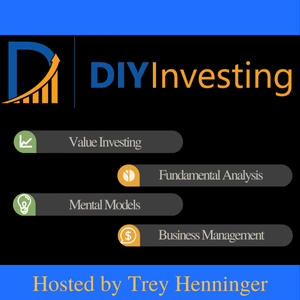
84 - Would you buy your employer's stock?
Mental Models discussed in this podcast:
- Scuttlebutt
- Circle of Competence
If you enjoyed this podcast and found it helpful, please consider leaving me a rating and review. Your feedback helps me to improve the podcast and grow the show's audience.
Follow me on Twitter and YouTubeTwitter Handle: @TreyHenninger
YouTube Channel: DIY Investing
Support the Podcast on PatreonThis is a podcast supported by listeners like you. If you’d like to support this podcast and help me to continue creating great investing content, please consider becoming a Patron at DIYInvesting.org/Patron.
You can find out more information by listening to episode 11 of this podcast.
Show OutlineThe full show notes for this episode are available at https://www.diyinvesting.org/Episode84
Scuttlebutt Challenge: Your Employer's Stock- If your company isn’t public, assess it qualitatively or do this work on your spouse's company or where a friend works.
- If you work for a non-profit or government, do the same.
- Email me your write-up during the month of July 2020 and I'll send you a response.
- Assess the industry
- Assess your company’s place in the industry
- What is the culture of your company like?
- What is the priority of management? Are they shareholder friendly? Are they employee-friendly? Other concerns?
- How are capital allocation decisions made?
- How are CapEx decisions made?
- Does your company earn high returns on capital?
- Does it use leverage?
- In summary: Is it a high-quality business?
- What are the risks?
- How would you value your employer’s stock? (Write down an explicit intrinsic value)
The company you work for should be the first place you look to begin understanding how to perform scuttlebutt. Investors should analyze their employer's stock as a potential investment candidate. Culture, Quality, and Management are key areas.
Next Episode

86 - The Tyranny of Backtesting: Why Backtests are harmful and counter-productive
Books Referenced:
Fooled by Randomness by Nassim Taleb
*If you purchase through this affiliate link, I will receive a small commission, at no additional cost to you. Your purchase will be supporting the show's continued production of free content.
Thank you for your support!
Mental Models discussed in this podcast:- A priori knowledge
- Deductive vs Inductive Reasoning
- Empirical Evidence
- The Scientific Method
- Curve Fitting and Extrapolation Problem
- Boundary Conditions
- Hindsight Bias
- Ergodicity
If you enjoyed this podcast and found it helpful, please consider leaving me a rating and review. Your feedback helps me to improve the podcast and grow the show's audience.
Follow me on Twitter and YouTubeTwitter Handle: @TreyHenninger
YouTube Channel: DIY Investing
Support the Podcast on PatreonThis is a podcast supported by listeners like you. If you’d like to support this podcast and help me to continue creating great investing content, please consider becoming a Patron at DIYInvesting.org/Patron.
You can find out more information by listening to episode 11 of this podcast.
Show OutlineThe full show notes for this episode are available at https://www.diyinvesting.org/Episode86
Why Backtests are harmful and counterproductive- Empirical Evidence - backtesting is a form of empirical evidence. I.e. observation of the past
- A priori knowledge - knowledge, justifications, or arguments that exist independently from experience. (Ex: Mathematics) (Wikipedia)
- a form of knowledge that can be derived by reason alone.
- Deductive reasoning - the process of reasoning from one or more statements to reach a logically certain conclusion. (Wikipedia)
- Inductive reasoning:
- “inductive reasoning as the derivation of general principles from specific observations (arguing from specific to general)” - Wikipedia (same link as below)
- “While the conclusion of a deductive argument is certain, the truth of the conclusion of an inductive argument is probable, based upon the evidence given.” -Wikipedia
- Scientific Method:
- Form a hypothesis
- Propose an experiment to test that hypothesis.
- Results of the experiment either support or disprove the hypothesis. No experiment can prove a hypothesis.
- The problem with the theory:
- A theory only follows the scientific method if it can be disproven. If a theory is unable to be disproven, then it is not a true scientific theory but something else.
- Curve Fitting and Extrapolation problem (using a curve or model beyond the range of observed data is subject to uncertainty)
- Boundary conditions.
- G Merani (Twitter) (Website) - Covers net-net study backtests in depth
Investors use backtests in order to test whether a portfolio's asset allocation would have performed well in the past. The use of backtesting is harmful to a portfolio because it ignores uncertainty and overstates the value of empirical evidence.
It is much better to reason from first principles using deductive reasoning. This deductive reasoning is better than inductive reasoning for investors because it eliminates hindsight bias.
If you like this episode you’ll love
Episode Comments
Generate a badge
Get a badge for your website that links back to this episode
<a href="https://goodpods.com/podcasts/the-diy-investing-podcast-15422/85-precisely-wrong-roughly-right-dcfs-7347212"> <img src="https://storage.googleapis.com/goodpods-images-bucket/badges/generic-badge-1.svg" alt="listen to 85 - precisely wrong, roughly right (dcfs) on goodpods" style="width: 225px" /> </a>
Copy
